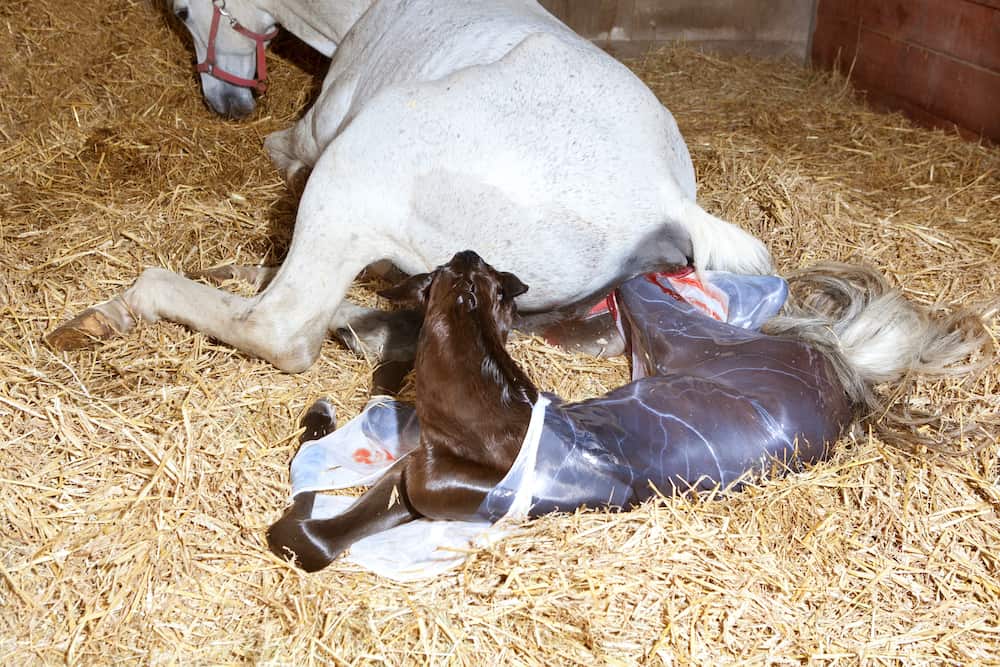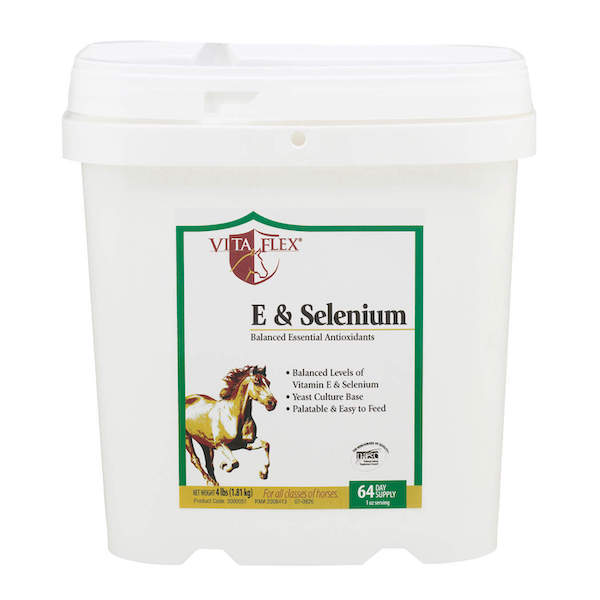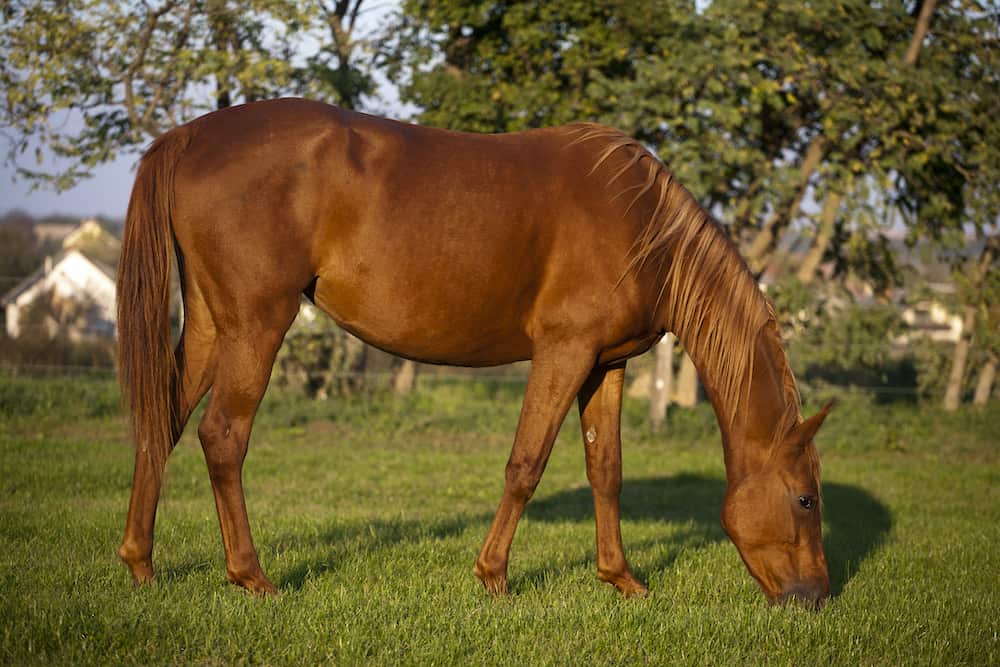
Mare Pregnancy Calculator
Estimate when your horse is due to give birth by entering the date of the first mating below and stay prepared for additions of new foals to your family!Protect your beloved pets without breaking the bank
- Unlimited video calls & texts with vets
- Available 24/7
- Annual $3,000 emergency fund
- LIMITED TIME - 7 DAYS FREE trial
- SPECIAL OFFER - 20% OFF 1st month
Code: GOODY20
- Flexible coverage
- Hassle free claims
- Multiple pets family plan
How Long Are Horses Pregnant?
Horse pregnancies can be quite stressful for both the animal and the owner or caretaker. Understanding the entire process makes a huge difference ensuring that you know exactly what to expect and what to do for the horse. That is why we have compiled this complete guide to a horse's pregnancy with everything you need to know from physical descriptions to major milestones.
The average gestation period for a horse is 320 to 362 days which corresponds to 11 to 12 months. However, most will deliver by day 330 to 345 of pregnancy making 11 months the most common gestation limit in horses.
Horse Pregnancy Calendar – A Week By Week Comparison
1st Month (1st trimester) - 0 to 30 Days
The first trimester begins when the ova from the mare is fertilized by the sperm from the stallion. This takes place during the mare's ovulation period and results in a single-celled structure referred to as the zygote. All this happens within theupper part of the oviductwhere the released egg was. This marks day 0 of the horse' pregnancy.
The zygote undergoes continuous division into a multi-cell bundle which slowly moves towards the uterus. By day 6 after fertilization, the bundle develops into an embryo the size of a pea. However, it does not settle in place and implant until day 15 to 17.
Ultrasounds must be performed between day 14 and 18 to rule out twin pregnancies. Another ultrasound on day 25 to 30 may be performed to detect a heartbeat.
The first month of pregnancy is generally a very delicate time for the mare and her growing fetus. They need to be kept well-rested which means riding or strenuous activities are to be avoided at all costs.
Furthermore, they need adequate nutrition to support the growing embryo. For this, we recommend Purina Animal Nutrition Purina Enrich Plus Ration Balance Pellet. The additional protein, vitamin, and mineral fortification perfectly supplement any missing elements in the horse's diet.
2nd Month (1st trimester) - 31 to 60 Days
For the first 10 days of the second month, the embryo is still considered an Embryo. The fetal stage officially begins on the 40th day after fertilization. Here, the physical features start to develop more distinctly. These include the facial features and a few joints including the shoulder which may be identifiable on ultrasound examination.
By the 40th day, the umbilical cord linking the mare to the fetus is also completely formed. This gives the fetus a lot more flexibility to move about within the amniotic sac in the uterus. Climbing movements could also be picked up on ultrasound by the 46th day.
For the most part, the horse is not in as much risk of losing the fetus as in the first month. They can therefore be safely ridden. However, the fetus is just beginning to settle into the womb and the risk, though small, is still there. Here, it is best to play it safe and consult your vet before exposing the mare to any kind of stress.
As the fetal development kicks into high gear, it is important now more than ever to ensure that the horse is enjoying a balanced diet. Both macronutrients and micronutrients play a crucial role in development of different structures and systems in the fetus. They are also important as a way to keep the mare strong and healthy during the rest of the pregnancy.
You could also start the horse on Farnam Vita Flex E Selenium Supplement. The combination is particularly effective when it comes to benefits like muscle development in the fetus. Selenium also improves immunity which is very important for a safe pregnancy.
3rd Month (1st trimester) - 61 to 90 Days
During this month of pregnancy, the fetus is still developing more discernible features. It will begin to look more and more like an adult horse in terms of frame. This is due to features like its tail, discernable joints, and elongated stance. All this can be picked up on ultrasound examination that can be scheduled for any day of the 3rd month.
While the fetus does start to resemble a foal, it is still quite small. In fact, by estimation it can be compared to an adult chipmunk. As a result, physical changes to the mare's belly may not be present to the untrained eye.
However, the mare is very aware of their pregnancy. This is because the 3rd month is where the fetus starts becoming very active. They instinctively move their limbs, neck, and back which is theorized to be in preparation for the coordination required to survive outside the womb.
As a result, the horse, though not obviously pregnant, may start to behave a little differently. They are often very cautious and will not readily engage in activities they instinctively feel will hurt their fetuses. This includes rough play, fights with other horses, running too fast, or shaking.
The 3rd month is also special because this is the first time where sexing can be conducted. This is an ultrasound examination meant to help determine the gender of the fetus. Due to the progressed development including that of external genitalia, this is very easy to pick out.
As far as care of the pregnant horse is concerned, the most important addition during this period is deworming regimens. These help protect both the mother and their fetus as they are both susceptible to infection and serious subsequent complications by worms.

4th Month (2nd trimester) - 91 to 120 Days
This is technically a transition month. In fact, the second trimester does not officially begin in horses until the 114th day of pregnancy. This is because there are generally no major milestones in either the fetus or the pregnant mare.
However, this does not mean that there are no discernible changes especially in the fetus.
By the 120th day of pregnancy, a thin layer of hair should have formed especially over the face on the muzzle and chin of the horse fetus. This also includes eyelashes.
Another more subtle change is in the facial appearance. The developing fetus at this stage of the pregnancy will start to look more like a foal. Their muzzles get longer and take on the shape of a horse's muzzle. Mouth parts are also more discernible as opposed to the closed or slit-like appearance in previous stages.
It is also important to note that while sexing is possibly towards the end of the 3rd month, examinations during the 4th and 5th months are the easiest and most accurate.
On the mare itself, there are no specific physical changes to be picked out. The belly may still be normal-looking as the fetus at this stage is rarely more than 2 pounds heavy or the size of a kitten.
All you have to do here is keep the horse well-fed with a balanced diet and supplements if necessary. Deworming can also be done during this month if not already done. Just get the vet's advice to be safe.
The horse can also return to normal working activities without much consequence. However, do not push them when they seem hesitant. They know best when it comes to protecting their unborn foals.

5th Month (2nd trimester) - 121 to 150 Days
This is a stage of both rapid growth in terms of size and development of features. By the end of the 5th month, the extremities should be fully formed including the hooves. The fetus still has space within the amniotic sac and may flex and extend them regularly.
The fetus could grow up to 11 pounds. This may cause signs like a slight increase in abdominal girth with a lower abdominal bump in the mare. This may be more pronounced than in previous months. However, the changes are still subtle enough that they may not be discerned by the inexperienced.
Due to the rapid growth, the fetus's energy demands also increase. As a result, you may notice an increase in the mare's appetite.
It is therefore important at this stage to increase their food portions to support both the horse and their fetus. We recommend the Standlee Hay Company Premium Alfalfa Pellet to be added to the horse's diet. It is a particularly good supplement for diets low in protein and complements fiber levels in the horse's main meals.
Another very subtle change you may notice by the 5th month is the horse may get moodier. This is as a result of pregnancy hormones which make them oscillate between periods of affection and reclusion. They may also show inexplicable aversion to stallions.
On day 150, the mare should receive their first dose of equine herpesvirus vaccine (EHV). They also get their second dose of deworming medicine on the same day.
6th Month (2nd trimester) - 160 to 180 Days
This is the actual midpoint in the pregnancy and where it starts getting more evident that the mare is expectant in terms of their size.
Inside, the fetus is going through very few changes. Their mane begins to develop but only as a very thin layer of fine hair all over the body. The tail also grows longer and thicker.
Due to the increased size of the fetus, the movement within the uterus is very minimal. However, they do begin to turn towards the cranial position that is maintained for the rest of the pregnancy.
For the most part, there isn't much to do in terms of taking care of the mare here. Just keep them well fed and monitor for any complications.

7th Month (2nd trimester) - 181 to 210 Days
As the second trimester draws to a close, the fetus grows much larger and starts to resemble a foal. They can actually get as big as 16.5 pounds. They are also at this point fully turned with the head facing the cervix in preparation for foaling later on.
The mane also grows considerably thicker and colors and markings may be discernible.
It is also during this trimester, in the 210th day to be specific, that the mare needs to receive their second dose of the Equine Herpesvirus Vaccine. This is also a good opportunity for general monitoring of the horse's well being as you prepare for the crucial and stressful 3rd trimester.

8th Month (2nd trimester) - 211 to 240 Days
Technically speaking, the 3rd trimester for a pregnant horse begins on day 226 of gestation. The rest is considered a transition period with very minimal changes both in the mare and the fetus.
For the most part, the only thing you may notice here is that the mane gets thicker for the fetus. The mare may also start to get much larger with the fetus weighing as much as 33 pounds.
To support this, increase the horse's food portions. You should also start to reduce the amount and intensity of activities for the mare.

9th Month (2nd trimester) - 241 to 270 Days
The fetus undergoes another growth spurt during this part of the 3rd trimester. In fact it is estimated that they can increase in weight at the rate of 1 pound per day. This has results that are very hard to miss on the horse itself including a large, almost sagging abdomen.
The most important thing you can do in this stage is to completely stop any form of work that the horse has to do whether it is being ridden or pulling carts. This is their bed-rest season which they definitely need for the pregnancy to be successful.
On the 270th day, the horse gets their 3rd dose of the EHV vaccine.

10th Month (2nd trimester) - 271 to 300 Days
This is quite close to the foaling stage and in some instances, the mare may actually deliver early. In these rare instances, the foal is for the most part fully formed with a thick coat. However, they may not be very strong.
The mare's belly here keeps getting larger as the fetus grows more and weighing up to 99 pounds. The horse therefore needs increased portions of their balanced diets. Mineral fortified foods or supplements are also crucial for the still-developing bones.
On day 300, additional vaccines may be administered on the vet's recommendations. These include an EHV booster and the third dose of deworming medication. It also includes vaccines in preparation for foaling including tetanus, flu, streptococcus and botulism vaccines.

11th Month (2nd trimester) - 301 to 339 Days or until foaling
The fetus may turn on their side while still in the cranial position. This increases the abdominal bulge especially from the front view.
Due to the heavy weight and position of the fetus, the horse may be in visible discomfort. You can help by preparing a comfortable and aerated space and keeping them well fed.
It is also important at this time in the pregnancy to constantly monitor for signs of foaling or late pregnancy complications.
With the former, one of the most important signs is distention of the udders and filling up with milk which happens about a week or 2 before the foaling.
The croup muscles under the tail may also start to appear relaxed about 1 or 2 days before the horse is ready to deliver. The most important prediction sign is production of milk or a waxy substance from the udder which happens about 24 hours before the foaling.

Foaling
Foaling is the process of delivering the foal from the mare's uterus. Under normal circumstances, this is a completely passive activity for the horse's caretaker.
However, you can prepare the mare by getting them to a clean and comfortable spot. You could also give them a quick washing especially their udders and perineal area under the tail.
Foaling takes place in 3 distinct stages.
The first stage begins when the horse starts to experience uterine contractions. Some of these are so powerful that you may actually see the tension on the abdomen. The horse will get restless as a result of the discomfort and may also urinate a lot. This stage typically lasts 1 to 2 hours.
The second stage of foaling in a horse begins when the amniotic sac ruptures and fluid is released. This is followed by a thin, white membrane then the foal itself. In normal situations, the foal will come out with the 2 front feet first then their head in a nose-first position. After this, contractions expel the foal within 10 to 20 minutes.
The final stage involves expulsion of the placenta and should happen within 3 hours of full delivery of the foal.

Postpartum care
The postpartum period in a horse starts from the delivery of the foal to between 10 and 25 days later.
The first step of care is ensuring that the placenta is completely removed and inspecting it for abnormalities. The horse's vitals should also ideally be monitored for at least 24 hours after the delivery. These steps are important for identifying any complications of foaling including postpartum hemorrhage which could be fatal if missed.
In the days following the foaling, it is also important to monitor the breastfeeding to see whether the mare is producing enough milk and if the udder is healthy and unclogged. You should also monitor for any foul discharge from the vagina which could indicate infections.
In addition to all this, postpartum care includes getting the horse to do some mild to moderate exercises. This helps improve their appetite and restore gut function to prevent constipation. It also helps with faster return of the uterus to its normal size which is known as involution.

Related Questions
Do Horses Go Into Heat When Pregnant?
No, horses do not go into heat when pregnancy. However, they may demonstrate signs similar to those of mares in heat during later months of pregnancy. These include tail elevation, changes to the vulva, and standing in a stretched out stance. Despite the similarities, the lack of appropriate hormonal and anatomical changes means that these symptoms in late pregnancy are not true heat.
Can You Ride A Pregnant Horse?
It is generally safe to ride a pregnant horse. You just have to get your timing right. One period to avoid is the first month after conception. During this time, the horse needs as much rest as possible for successful implantation.
The second period to avoid riding a pregnant horse is the last 3 months of pregnancy. Here, they may not be energetic or agile enough for the job.
Can A Mare Produce Milk Even If Not Pregnant?
It is actually possible for a mare to produce milk even when they are not pregnant. This happens as a result of abnormal regulation of hormones responsible for formation and release of milk. It could be due to hormonal diseases like Cushing's syndrome. It could also be due to tumors in the glands producing the hormones involved.





